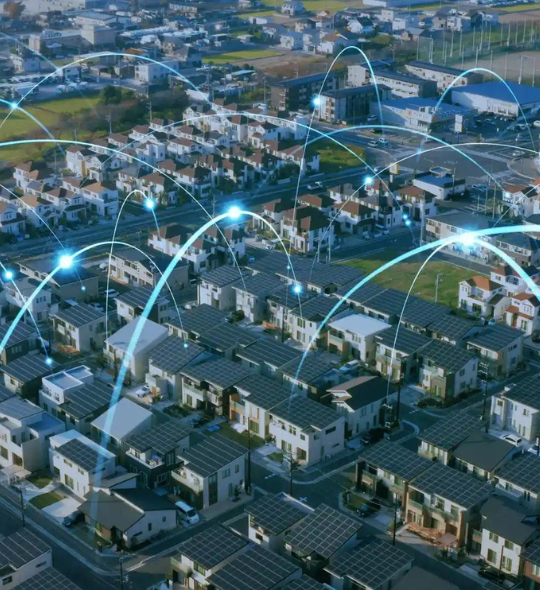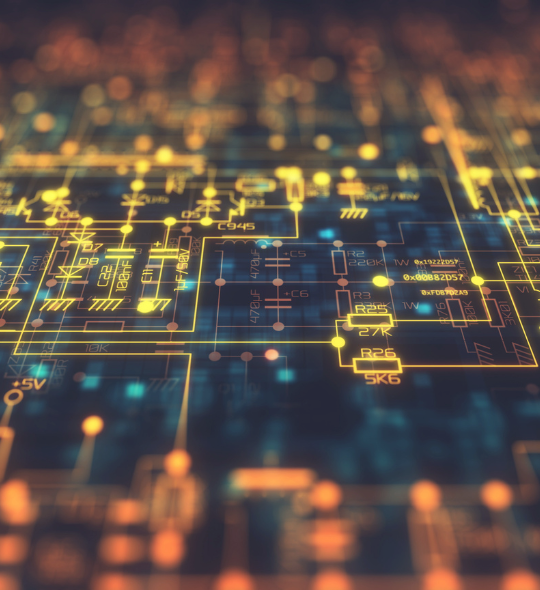
What exactly is the 4th Industrial Revolution? It refers to how we operate and produce, and centres around digitization; specifically, the ways in which data is increasingly becoming the commodity, and how formerly analogue items and practices are being augmented.
We’re all familiar with the myriad upheavals and disruptions facing society, from civic campaigns for greater justice, to the demands of climate change, and the need to transition to a more sustainable economy.
Among these disparate movements and paradigm shifts, there is yet another revolution underway – namely the 4th Industrial Revolution – itself tied to wider ecological and economic concerns.
In case you are wondering what the first three revolutions were, they refer to the advent of mechanization (c.1780), electrification (c.1870), and automation (c.1970).
These changes to global industry (together with what is seen as Revolution 3.5 – globalization beginning around 1980) have each accelerated and radically reorganized our productive capacities.
The fact that these successive revolutions have become more frequent (i.e. arriving every few decades as opposed to every hundred years or so) indicates the exponential increase in technological development that has characterized the second half of the 20th and first decades of the 21st centuries.
What do we mean by the 4th Industrial Revolution?
But just what exactly is the 4th Industrial Revolution? This emerging term refers to how we operate and produce, and centres around digitization; specifically, the ways in which data is increasingly becoming the commodity, and how formerly analogue items and practices are being augmented.
Pierre Cléroux, vice-president of research and chief economist at the Business Development Bank of Canada (BDC) explains the concept as follows: “the core application of Industry 4.0 is to monitor and control your machinery and equipment in real time by putting sensors at every step of the production process.”
“Imbuing previously analogue and cumbersome processes with the means to react spontaneously to changing circumstances aids both survivability (resilience to change) and innovation.”
The proliferation of sensors and metadata allows for unprecedented levels of tracking and manipulation, allowing companies to fine-tune their enterprises with lightning speed. This in turn greatly increases the agility and flexibility of these companies when responding to both new opportunities and new threats.
Imbuing previously analogue and cumbersome processes with the means to react spontaneously to changing circumstances aids both survivability (resilience to change) and innovation.
For instance, companies adopting IoT technologies are better equipped to weather the vagaries of climate change, which are upending establishing climate data and can prove especially disruptive to renewable (e.g. solar and wind) generation.
In addition, more frequent heat spikes will require companies to curtail their energy use more frequently.
How the 4th Industrial Revolution impacts manufacturing and industry
With regards to the energy sector, the 4th Industrial Revolution offers new opportunities to modernize how we manage our energy usage. Much is written about the need to diversify and green our global energy makeup if we want to seriously tackle climate change.
While new technologies and generation sources play important roles, the amount of wasted energy and other inefficiencies need to be effectively tackled if we are to make the most of this energy transition.
It is all well and good to have the latest gadgetry and eco-friendly energy sources, but if a substantial amount of the energy generated is being wasted, and we don’t know where and to what degree, then our efforts in other areas are undermined.
Industry 4.0 encompasses the suite of monitoring and proactive response measures that are currently being adopted, albeit in a piecemeal manner. As things stand, the main facilitator of the emergence of Industry 4.0 is what is known as the Internet of Things (IoT).
This term refers to how previous ‘dumb’ items (e.g. fridges, water heaters, solar panels, window blinds, and A/C units, to name just a few) are being made ‘smart’ by incorporating sensors which are connected to the Internet.
Applying internet-connected components to these previously ‘blind’ devices in turn allows them to be incorporated into networks, allowing them to talk to us and act in real time to our instructions (or plans). We are already familiar with this concept – think of a digital home assistant, like Alexa or Google Home turning on your smart TV or lights when you tell it to.
Where the IoT goes further is in laying the groundwork for our devices and products to talk to each other, independent of any human input. This is where developments in 5G networks comes into play, as it is this fifth generation of networks that provides the required amount of bandwidth to handle all these device-to-device conversations.
How EnPowered is working towards leveraging Industry 4.0 to help our customers
At the moment, energy consultants like EnPowered send customers alerts when we predict a Peak, which in turn prompts customers to implement the recommended demand response actions.
EnPowered’s machine learning algorithms and real time market monitoring helps us provide customers with the relevant information as fast as possible, but there is still a delay, a missing link in the digital chain between receiving a message and implementing the advice.
This digital gap creates delays and raises the potential for errors, because someone on site has to physically access a control panel, or go to another floor or building to manually adjust machinery and system parameters.
The ideal state of affairs would be one which enables a company’s various systems (HVAC, lighting, refrigeration, production lines etc.) to automatically react to the aforementioned messages.
In other words, the relevant equipment would instantly implement recommendations as soon as they were sent, regardless of time of day, location, or whether any employees were actually on site.
Such an arrangement means less work and distractions for businesses and more accurate Peak mitigation, especially in scenarios where EnPowered is given access to company IoT networks, (and enabling coordinated responses across multiple systems) thereby eliminating the need for dedicated response personnel/capacity.
Fewer employees on the ground means fewer chances for accidents to occur, and ubiquitous sensors allow for the immediate identification of malfunctioning or soon to be malfunctioning equipment, thus reducing injuries.
Another important benefit of embracing IoT is the savings it can deliver, both on energy bills and emissions. Industry accounts for 54% of global delivered energy, so finding out when and where you are wasting/losing energy can lead to significant savings while also helping the environment.
Integrating your facility and machinery with EnPowered would also allow us to tailor energy use patterns to coincide with cheaper rates, as well as those times when renewable energy is more available and cheaper, thus reducing your business’ carbon footprint.
This can be taken a step further by introducing the concept of smart grids, whereby distributed sensors would be able to provide grids with far more accurate power usage information, with the grid in turn incorporating this data and responding accordingly.
W. David Stephenson, author of The Future is Smart, explains that the marriage of IoT with smart grids, “facilitates integrating renewable energy, plug-in hybrid vehicles, and energy efficiency innovations:” smart grid implementation alone is projected to reduce emissions by almost 4% by 2030.
Industry 4.0 at work: An energy example
Let’s imagine a scenario which incorporates all the things we have been talking about. In this scenario, a business is being contacted by EnPowered due to a Peak event warning during a heatwave. To begin with, EnPowered’s machine learning algorithms predict that a Peak will occur, say between 2-3pm.
Your business has invested in a facility automation centre, which facilitates and coordinates the device-to-device interactions discussed above. Having granted EnPowered access to your automation centre, you’ve provided us with the ability to remotely control your devices and machinery.
Consequently, an alert is sent to the business’ internal network with instructions on how to reduce its energy usage. In response to EnPowered’s recommendations, the networked facility enacts response strategies, automatically decreases cooling efforts in a non-essential part of the facility, dims or shuts off lighting as needed, and temporarily shuts off ancillary equipment, like drinking fountains, vending machines, and lawn sprinkler systems.
Predictive maintenance will save companies $630 billion by 2025, mainly from reducing costs from unscheduled downtime.
At the same time, the system recognizes which parts of the facility are receiving the most sunlight and lowers the blinds and/or dims the reactive windows to help lower cooling needs.
During this time, the capacity of one production line is reduced by 15%, with the system automatically scheduling more work on the coming weekend to make up the difference.
Fortunately, EnPowered was able to provide several days notice of this impending Peak, so the company network has already pre-scheduled regular maintenance work for today, allowing one section of the business to shut down, thus saving energy and eliminating unnecessary downtime, since the maintenance would have to have been performed at some point anyway.
This kind of predictive maintenance will save companies $630 billion by 2025, mainly from reducing costs from unscheduled downtime.
The company in question has also invested in battery and behind-the-meter (on site, localized) generation capacity, known as Distributed Energy Resources (DERs). By switching to these alternate energy sources, the company is able to reduce its impact on the grid, decreasing its load on the system without having to curtail more than necessary (if at all).
For the purposes of this example, we’ve highlighted a wide-range of response options, but during any given Peak a company may need to employ only some of these responses. Regardless of the scale of a firm’s response, the key takeaway to consider here is the manner in which the response is coordinated and executed.
All the actions described above can be undertaken in a fully automatic and holistic manner, without the need for direct intervention by company personnel, thereby providing a faster and more precise response than ever.
This isn’t science fiction – all the technologies and processes described in this article are currently available and market ready, with adoption already underway in many industries. Any company serious about increasing efficiency, reducing energy costs, and minimizing its carbon footprint needs to approach Industry 4.0 in a concerted way.
We encourage you to get in touch with EnPowered, to discuss your options and move forward on a plan that works for your business.





